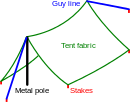
Camping is a form of outdoor recreation or outdoor education involving overnight stays with a basic temporary shelter such as a tent. Camping can also include a recreational vehicle, sheltered cabins, a permanent tent, a shelter such as a bivy or tarp, or no shelter at all. Typically, participants leave developed areas to spend time outdoors, in pursuit of activities providing them enjoyment or an educational experience. Spending the night away from home distinguishes camping from day-tripping, picnicking, and other outdoor activities.

A tent is a shelter consisting of sheets of fabric or other material draped over, attached to a frame of poles or a supporting rope. While smaller tents may be free-standing or attached to the ground, large tents are usually anchored using guy ropes tied to stakes or tent pegs. First used as portable homes by nomads, tents are now more often used for recreational camping and as temporary shelters.

A tipi, often called a lodge in English, is a conical tent, historically made of animal hides or pelts, and in more recent generations of canvas, stretched on a framework of wooden poles. The word is Siouan, and in use in Dakhótiyapi, Lakȟótiyapi, and as a loanword in US and Canadian English, where it is sometimes spelled phonetically as teepee and tepee.
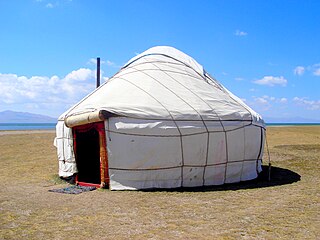
A yurt or ger (Mongolian) is a portable, round tent covered and insulated with skins or felt and traditionally used as a dwelling by several distinct nomadic groups in the steppes and mountains of Inner Asia. The structure consists of a flexible angled assembly or latticework of wood or bamboo for walls, a door frame, ribs, and a wheel possibly steam-bent as a roof. The roof structure is sometimes self-supporting, but large yurts may have interior posts supporting the crown. The top of the wall of self-supporting yurts is prevented from spreading by means of a tension band which opposes the force of the roof ribs. Yurts take between 30 minutes and 3 hours to set up or take down, and are generally used by between five and 15 people. Nomadic farming with yurts as housing has been the primary life style in Central Asia, particularly Mongolia, for thousands of years.

A tarpaulin or tarp is a large sheet of strong, flexible, water-resistant or waterproof material, often cloth such as canvas or polyester coated with polyurethane, or made of plastics such as polyethylene. Tarpaulins often have reinforced grommets at the corners and along the sides to form attachment points for rope, allowing them to be tied down or suspended.

A tree house, tree fort or treeshed is a platform or building constructed around, next to or among the trunk or branches of one or more mature trees while above ground level. Tree houses can be used for recreation, work space, habitation, a hangout space and observation. People occasionally connect ladders or staircases to get up to the platforms.

A shelter-half is a simple kind of partial tent designed to provide temporary shelter and concealment when combined with one or more sections. Two sheets of canvas or a similar material are fastened together with snaps, straps or buttons to form a larger surface. The shelter-half is then erected using poles, ropes, pegs, and whatever tools are on hand, forming an inverted V structure. Small tents like these are often called pup tents in American English.

An awning or overhang is a secondary covering attached to the exterior wall of a building. It is typically composed of canvas woven of acrylic, cotton or polyester yarn, or vinyl laminated to polyester fabric that is stretched tightly over a light structure of aluminium, iron or steel, possibly wood or transparent material. The configuration of this structure is something of a truss, space frame or planar frame. Awnings are also often constructed of aluminium understructure with aluminium sheeting. These aluminium awnings are often used when a fabric awning is not a practical application where snow load as well as wind loads may be a factor.

Lavvu is a temporary dwelling used by the Sami people of northern extremes of Northern Europe. It has a design similar to a Native American tipi but is less vertical and more stable in high winds. It enables the indigenous cultures of the treeless plains of northern Scandinavia and the high arctic of Eurasia to follow their reindeer herds. It is still used as a temporary shelter by the Sami, and increasingly by other people for camping. It should not be confused with the goahti, another type of Sami dwelling, or the Finnish laavu.

The Volkswagen Westfalia Camper was a conversion of the Volkswagen Type 2, and then, the Volkswagen Type 2 (T3), sold from the early 1950s to 2003. Volkswagen subcontracted the modifications to the company Westfalia-Werke in Rheda-Wiedenbrück.

The Sibley tent was invented by the American military officer Henry Hopkins Sibley and patented in 1856. Of conical design, it stands about 12 feet (3.7 m) high and 18 feet (5.5 m) in diameter. It can comfortably house about a dozen men.

A roof tent or rooftop tent (RTT) is an accessory which may be fitted to the roof or bed of a motor vehicle which allows the users to sleep in relative safety and comfort above the vehicle, and leaves the internal load-space free. The first example of roof-tents appeared in Western Europe in the 1930s.
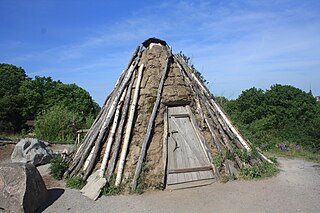
A goahti, goahte, gåhte, gåhtie or gåetie, ,, is a Sami hut or tent of three types of covering: fabric, peat moss or timber. The fabric-covered goahti looks very similar to a Sami lavvu, but often constructed slightly larger. In its tent version the goahti is also called a 'curved pole' lavvu, or a 'bread box' lavvu as the shape is more elongated while the lavvu is in a circular shape.

A chum is a temporary dwelling used by the nomadic Uralic reindeer herders of northwestern Siberia of Russia. The Evenks, Tungusic peoples, tribes, in Russia, Mongolia and China also use chums. They are also used by the southernmost reindeer herders, of the Todzha region of the Republic of Tyva and their cross-border relatives in northern Mongolia. It has a design similar to a Native American tipi but some versions are less vertical. It is very closely related to the Sami lavvu in construction, but is somewhat larger in size. Some chums can be up to thirty feet in diameter.

A loue is an ultra-light Finnish open tent-like shelter. It is used to give reasonable protection from wind and rain during a variety of outdoor activities, including camping, canoeing, hiking and hunting. Loues are popular with Scout groups and minimalist campers. Suitable as one or two person shelters, they are compact, light and can be set up and taken down in a basic way fairly quickly. The workman-like sets shown in photographs indicate that more effort can be made to stiffen the sides and the stakes and lines used can complicate a taut setup. The open front permits fire viewing, ventilation and looking out over a scenic view. A loue consists of a roughly conical section of fabric with the semi-circular bottom edge grounded by stakes and the tip raised with a single pole. Suitable standing tree trunks may be used to suspend the tent if an open campfire is not to be used. This style of ''tarp tent" can best be raised using a scissors-pole assembly. A pole suspension system allows for positioning an open fire in front of the shelter without the risk of damaging tree trunks or roots. The panels of a true Finnish loue are designed to provide a semi-circular short wall around the shelter and a triangular piece at the tip can be let down to provide a little more shelter in front. With suitable siting and careful staking and tensioning, the side walls can be set close to the ground, providing protection from drafts and lifting from winds.
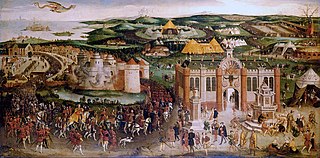
A pole marquee or pole tent is a variety of large tent often used to shelter summer events such as shows, festivals, and weddings. They are particularly associated with typical English country garden weddings and village fetes.
A Truck tent is a tent designed to be set up in the bed of a pickup truck. It was invented in 1990 by Roman Napieraj, founder of Napier Enterprises.

Glamping is a portmanteau of "glamorous" and "camping", and describes a style of camping with amenities and, in some cases, resort-style services not usually associated with "traditional" camping. Glamping has become particularly popular with 21st-century tourists seeking modern amenities, such as Wi-Fi, alongside "the escapism and adventure recreation of camping", in a variety of accommodations such as cabins, treehouses, and tents.
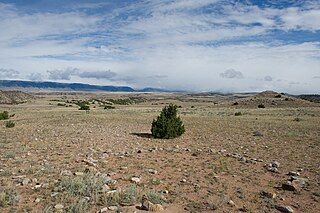
Tipi rings are circular patterns of stones left from an encampment of Post-Archaic, protohistoric and historic Native Americans. They are found primarily throughout the Plains of the United States and Canada, and also in the foothills and parks of the Rocky Mountains.
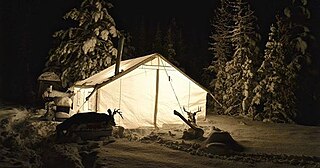
A wall tent, also known as a canvas tent, outfitter tent, safari tent, or sheep herder tent is a type of tent that has four straight vertical walls that provide more headroom than traditional pyramid-shaped tents. Wall tents are typically made of a heavy canvas and are used by hunters because they can accommodate several people and their supplies. Wall tents are suitable as a four-season tent, as they are able to accommodate a wood stove. Wall tents are commonly used in Civil War reenactments, and, in recent years, have also become used for glamping. Frames may be either internal or external. Tents are light weight yet sturdy. They are easy to carry and not too difficult when it comes to setting them up.




















